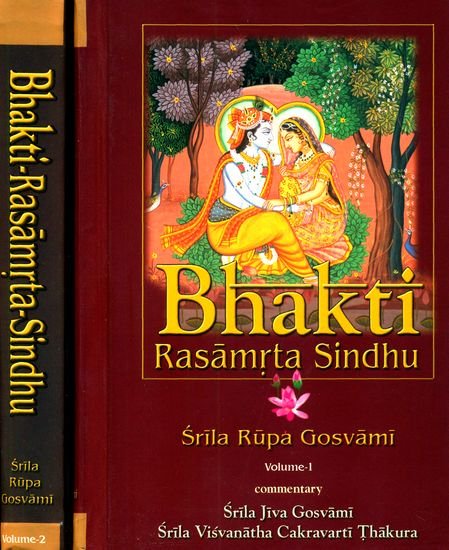Bhakti-rasamrta-sindhu
by Śrīla Rūpa Gosvāmī | 180,912 words
The English translation of the Sri Bhakti-rasamrta-sindhu verse 3.2.10; a medieval era Sanskrit book, written by Rupa Goswami (fl. 15th century) which represents a devotional (bhakti) masterpiece. In this work Goswami describes the nature and different forms of pure love (rasa) as well as various other topics on Vaishnavism and devotion.
Verse 3.2.10
Sanskrit text, Unicode transliteration and English translation:
तत्र चतुर्भुजो, यथा ललित-माधवे (५.१५) —
चञ्चत्-कौस्तुभ-कौमुदी-समुदयः कौमोदकी-चक्रयोः
सख्येनोज्ज्वलितैस् तथा जलजयोर् आढ्यश् चतुर्भिर् भुजैः ।
दिव्यालङ्करणेन सङ्कट-तनुः सङ्गी विहङ्गेशितुर्
मां व्यस्मारयद् एष कंस-विजयी वैकुण्ठ-गोष्ठी-श्रियम् ॥३.२.१०॥tatra caturbhujo, yathā lalita-mādhave (5.15) —
cañcat-kaustubha-kaumudī-samudayaḥ kaumodakī-cakrayoḥ
sakhyenojjvalitais tathā jalajayor āḍhyaś caturbhir bhujaiḥ |
divyālaṅkaraṇena saṅkaṭa-tanuḥ saṅgī vihaṅgeśitur
māṃ vyasmārayad eṣa kaṃsa-vijayī vaikuṇṭha-goṣṭhī-śriyam ||3.2.10||
English translation
The four-armed form, from Lalita-mādhava:
“Kṛṣṇa, victorious over Kaṃsa, wearing the flashing Kaustubha jewel around His neck, holding the cakra, club, lotus and conch in His four hands, whose body is ornamented with extraordinary jewels, and who is accompanied by Garuḍa, makes me forget the splendor of Vaikuṇṭha.”
